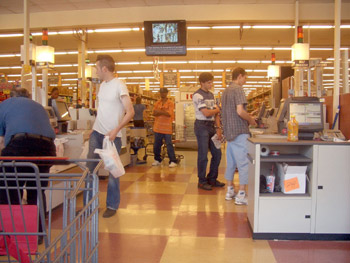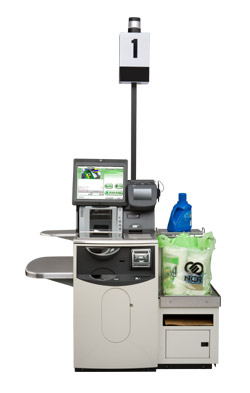Check it out

They said it wouldn’t catch on but self check-out is even making its way into small independent supermarkets. GILLIAN HAMILL scans the sector for advice on today’s solutions
17 August 2009
Will my customers like it? A key concern for many retailers who are considering introducing self check-out technology. However, customers are increasingly keen to join self check-out lanes and avoid lengthy queues in the process, says Declan Torsney of Wincor Nixdorf. “For example, in the UK the Anglia Co-op group which has 40 stores, has seen a 45% uptake on self check-out which is rising all the time. People are enjoying it and are much more relaxed because they’re not in a long queue.”
Dominic Feeney, systems director, CBE agrees: “Global research shows that a significant number of shoppers prefer to use self check-out.” In fact, a performance analysis at a CBE customer site showed a 41% increase in self check-out usage and a 47% increase in spend through a four terminal cluster over a twelve week period during the second quarter of 2009.
Self-service friendly
What’s more, Stephen Loughney of NCR believes Ireland has a particularly self-service friendly culture. Age is not a significant factor in this acceptance, says Loughney, who notes that those in the older age categories are sometimes actually most likely to embrace self check-out; they’re determined not to be “beaten down” by new technologies.
A 2007 survey conducted by NCR in the Irish market, showed 98% of respondents have used self check-out, and 44% said they “really like” self check-out. Furthermore, 91% said they would use self-checkout, even if they don’t like it, while 28% use self check-out more than 70% of the time. Significantly, only 9% of people surveyed said they would never use it.
While customer satisfaction is obviously important however, Loughney believes retailers are increasingly looking at the “hard” benefits self check-out can deliver, and examining return on investment (ROI). In this regard, he says that self check-out can deliver a better ROI than almost any other technology; because retailers start making cost savings from the first day self check-out is installed.
 Impressive returns
Impressive returns
According to Loughney, ROI is normally achieved in a year and a half; “pushing down almost to a year.” NCR has found in Ireland however that using self check-out lanes allows retailers to make a saving of 150 hours front end labour, per week, per store. He has calculated, based on an hourly wage of €14, that if a group has 100 stores and a net margin of 3% (Tesco recently published a UK net margin of 4%), this will create a net gain per annum of €6,726,991 and a gain over the seven years life expectancy of the solution of €53,073,489 – “phenomenal savings.”
Dominic Feeney highlights moreover that CBE is now making self check-out accessible to independent retailers and can provide the specific system they need at a reasonable price. He states the typical return on investment period is relatively short at 30 months based on an average seven year investment. “The savings generated through labour optimisation are significant as well as the customer retention through improved customer loyalty.”
Declan Torsney adds: “The traditional ROI on these systems vary depending on the product type that you choose. However if you opted for a straightforward scan and payment, the ROI is about 12 to 18 months.”
Even more efficiency
Recent technological developments are also helping to make self check-out units even more efficient. One such development, says Torsney, is the integration of cash management in self check-out units, which allows cash to be recycled. This protects a store from thefts and robberies, as the heavy duty security cases which cash-in-transit companies, such as Securicor and G4 need, are actually already built into the units.
Weight capture facilities on automated check-outs also enhance security for retailers. This feature means that if a product which hasn’t been scanned is put into a bag, it will show as an error on screen. The system can be programmed to a more sophisticated level also, as weights for certain products can be built into the system. Subsequently, for example, if a customer scans a product that should weigh one pound, but an item weighing only half a pound is put into a bag, this will also show as an error.
Continuing on the subject of new developments, Stephen Loughney adds that NCR has also started to “deploy tests of our new self-service unit that has features such as two-sided printing on receipts, to reduce the amount of paper used and increase printing speed. Higher performance scanners are also faster, meaning it’s easier for people to scan their products.
“There’s also new bulk coin input – instead of customers feeding in money coin by coin, they can just drop the coins into a cup in a bunch, and they all get fed in.”
Self-scan satisfaction
Self-scan handheld mobile units are another development which are increasingly attractive to retailers and customers. Loughney believes that retailers such as Tesco and Sainsbury’s who have been using self check-out for a number of years are now looking to “drive it further.” One way to do this is to further integrate self-scan, where customers scan each item they put into their trolley or basket as they walk around the store. He does note however that there can be more security issues surrounding self-scan than traditional self check-out.
He believes NCR have found a solution to such security issues in Italy though – Italy being one of the main adopters of self-scanning. In this case, when customers have finished their trolley shop using a handheld scanner, they wheel it to a self check-out machine. When they scan a barcode on top of the machine, their entire transaction appears on screen, so that they can see all discounts being applied.
This is beneficial for retailers as it “greatly facilitates partial rescans,” which “really helps drive security on self-scan…It’s also a great way of making it easier for the customer, because you don’t need to inconvenience them by rescanning all their items. A partial rescan only needs a couple of items but statistically it really helps to reduce any shrink retailers
might have.”
Revolutionising the trolley
GS1 has also introduced a revolutionary new piece of technology, which gives customers more freedom. GS1 Spain, part of the global supply chain standards body, has presented for the first time in Spain, the ‘Grocer’ – an intelligent shopping cart developed with European funds. This company states this, “radio frequency identification equipment, designed under the EPC standard, can provide the consumer with an authentic shopping experience.”
The cart is equipped with an RFID reader, an antenna and a touch-screen that allows the consumer to interact with the system sending and receiving information.
The intelligent cart, developed “with the goal of improving efficiency within the supply chain and retail business,” delivers advantages for both retailers and consumers. On one hand, the consumer can always know the exact price of the product that they have placed inside the cart, as well as the total cost of the purchase. They can also receive information about promotions, access to receipts and a list of the needed ingredients for a particular recipe, or can use the cart just to find the fastest way inside the shop to a certain product.
On the other hand, Grocer allows companies to offer more information and a much more customised service to the consumer, enabling inventory optimisation, a more effective marketing strategy and increased consumer loyalty.
Expanding into convenience
However, the most significant development in the self check-out sector overall, according to CBE’s Dominic Feeney is the fact it’s now expanding from tier one retailers to independents and convenience stores. “For the first time independent retailers can now avail of one of the most progressive retail technologies to help grow their profits and enhance their businesses,” notes Feeney. “The self check-out concept, which up to now was only available to the multiples, has been brought to a new level by CBE, Ireland’s number one EPOS provider, in partnership with Fujitsu, one of the world’s leading retail technology providers.”
“The convenience option is very practical where less space is available,” he continues. “It provides a smaller number of self check-outs (typically two) that are located opposite or near a manned station. A sales assistant monitors the two terminals while also serving customers at their own till, providing a cost efficient solution for this store format. The sales assistant uses a hand held terminal to monitor self check-out activity and verify restricted items, thus reducing space required for the monitoring station used in larger format stores.”
Consultative process
Declan Torsney of Wincor Nixdorf also believes self check-out can prove a feasible concept for the convenience sector. He stresses that Wincor engages in a consultative process with each retailer before it implements a system. “We analyse how the system can best work according to the frequency of the shopper, the transaction time, how long the customer is in the store for, what business hours the retailer is open, and the number of checkouts and lanes the store currently has.” He adds that Wincor’s Towerline 100 product would be particularly suitable for small convenience stores. In his view, self check-out would be especially relevant for 24 hour convenience stores, because the machines’ integrated cash management means the operator doesn’t actually touch any cash, which discourages robberies.
Stephen Loughney of NCR agrees that while: “It’s tended to be big guys who’ve done it first; definitely now the next area focus is going to be in the convenience sector.”
However he does emphasise: “Everything is driven by analysing what’s happening in the store. If every customer is buying cigarettes with every transaction, your target base for your shelf check-out installations is going to be smaller, so you have to look at all these features, in order to build a really accurate business case.” NCR operates the TOUR process which helps retailers analyse these factors, while CBE can also provide extensive advice.
Future growth
So what then does the future hold for self check-out technology? Dominic Feeney explains: “Based on the recent global research and trends in retail technology development worldwide, we at CBE took a strategic decision to develop a solution for independent retailers. We have received a positive response based on performance of self check-out to date and our sales team have many customer demonstrations planned.
“We would expect that self check-out will become a standard feature of many supermarket and convenience formats in the next two years. Retailers are listening and responding to savvy shopper needs, and in doing so are building a stronger platform for the long term success of their businesses resulting in cost optimisation and profit maximisation.”
Declan Torsney adds furthermore that a consultancy report in 2005 showed 44% annual growth in self checkout systems worldwide. He adds: “I believe that self checkout will take off in Ireland. There’s a number of convenience retail stores in this country with seven to 10 checkouts and it’s very suitable for those people.”
A similar positivity emanates from NCR’s Stephen Loughney, who gives a potent example of self check-out’s popularity. “Recently I saw that Sainsbury’s stated goal was to have potentially about 50% of all checkout to be automated in one form or another, and 50% to be manned.
“A real driver of the market however, has been the design and analysis of what is required before the technology is installed. This business is not about just selling the machine, you have to have the whole package.”



 Print
Print






Fans 0
Followers